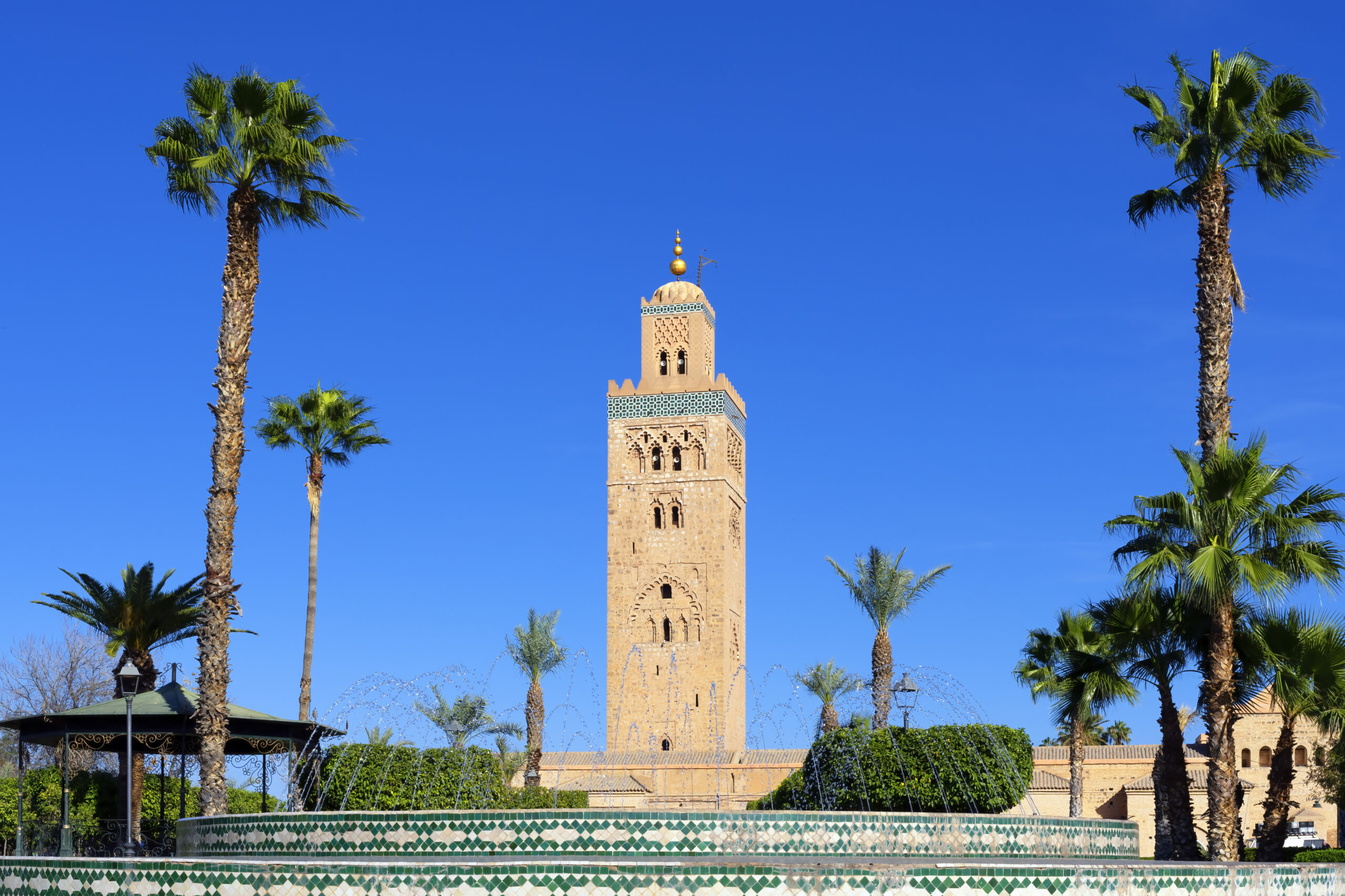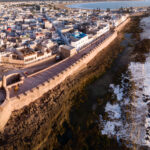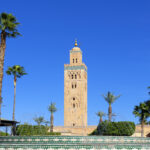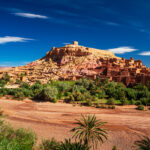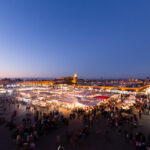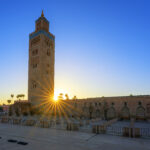Marrakech, often called the “Red City” or “Ochre City” due to its reddish hues, draws more tourists than any other city in Morocco. This city of contrasts intertwines modern life with history, creating a vibrant atmosphere that captivates visitors. From the circus-like square of Jemaa El-Fnaa to ornate palaces and stunning gardens, Marrakech offers something for everyone. Whether you’re a history buff, a shopaholic, or just seeking adventure, Marrakech won’t disappoint. Here are the top 11 reasons to visit Marrakech, the fabled Red City, and why it should be on your list of reasons to visit Morocco.
1. Visit Bahia Palace
Bahia Palace stands as one of the must-visit sites in Marrakech. Built in the late 19th century, Grand Vizier Si Moussa intended it to be the greatest palace of its time, blending Islamic and Moroccan architectural styles. His son, Abu “Bou” Ahmed, later expanded the palace. The stunning architecture features intricate tilework, painted wood ceilings, carved stucco, and cedar. The palace also includes a two-acre garden with rooms that open onto a courtyard.
More than just a beautiful structure, Bahia Palace tells the stories of those who once lived there. The harem section, which housed 24 women, reflects the era’s customs and the complexities of life within the palace walls. Despite its beauty, the palace reminds us of a time when women often faced confinement, with little to no freedom.
Located in the medina on Avenue Imam El Ghazali, Bahia Palace welcomes visitors daily from 9 AM to 5 PM. Entrance is free, allowing everyone to explore this piece of Moroccan history.
2. See the Saadian Tombs
The Saadian Tombs offer another significant historical site in Marrakech. These mausoleums house the remains of 60 members of the Saadi Dynasty, which ruled Morocco from 1549 to 1659. Ahmad al-Mansur, the most famous ruler, rests here. After the dynasty fell, the tombs remained sealed off and hidden until rediscovered through aerial photography in 1917. The French then restored the tombs, revealing their former glory.
You can find the tombs in a beautifully decorated building with finely carved cedar and stucco, intricate tilework, and monuments made of Italian Carrera marble. The tombs themselves are simple, in keeping with Islamic tradition, with graves facing Mecca. The Saadian Tombs are located at Rue de La Kasbah and are open from 9 AM to 5 PM during the week and from 9 AM to 3 PM on weekends. Admission is 70 MAD (about $6.70 USD), and arriving early helps avoid the crowds.
3. Shop in Jemaa El-Fnaa
No visit to Marrakech is complete without experiencing the chaotic yet fascinating Jemaa El-Fnaa square. This market bombards your senses with snake charmers, monkey handlers, and vendors selling everything from spices to souvenirs. The market divides into sections, each specializing in different goods like spices, pottery, leather, and metalwork. Be prepared to haggle if you want a good deal, as bargaining is part of the shopping experience in Marrakech.
Jemaa El-Fnaa offers more than just shopping; it’s a prime spot for people-watching. The square constantly buzzes with activity, making it an exhilarating experience. If you need a break, several restaurants and pastry shops line the market’s edges. Patisserie Lala Moulati, a popular spot, provides a rooftop deck where you can relax with a pot of mint tea while still watching the action below. Don’t forget to try Moroccan pastries like briouat or schnek, which are delicious treats.
4. Explore the Museum of Marrakech
Housed in the grand Dar Menebhi Palace, the Museum of Marrakech offers a must-see destination for art and history lovers. Originally built as a minister’s riad, the palace exemplifies Moorish architecture, featuring fountains, a central courtyard, and intricate carvings. The Omar Benjelloun Foundation restored the palace, establishing the museum in 1997.
The museum’s collection includes modern and traditional Moroccan art, coins, books, and pottery from various Moroccan cultures, including Berber, Islamic, and Jewish. The enormous chandelier made of metal plates in fine geometric patterns stands out as a highlight. The museum remains less crowded than other sites, offering a more peaceful experience of Moroccan architecture and art.
You can find the Museum of Marrakech on Place Ben Youssef, open daily from 9 AM to 6:30 PM. Admission costs 50 MAD (around $4.75 USD), making it an affordable cultural experience in the heart of Marrakech.
5. Wander Around Ben Youssef Madrasa
Ben Youssef Madrasa, once the largest Islamic college in Morocco and North Africa, showcases stunning Moroccan architecture. Founded in the 14th century, it gained its intricate decorations during the Saadian era in the mid-16th century. The madrasa’s main courtyard, with its shallow reflective pool, is surrounded by two open-air galleries and student dorms, all displaying Andalusian architectural elements like gardens, fountains, and elaborately decorated walls.
The madrasa offers a peaceful place to explore, providing a glimpse into Morocco’s educational and architectural history. An inscription above the entrance reads, “You who enter my door, may your highest hopes be exceeded,” welcoming visitors to this historic site.
Located at Rue Assouel, Ben Youssef Madrasa opens daily from 9 AM to 6 PM. The entry fee is 40 MAD (about $3.85 USD), making it an affordable and enriching experience in Marrakech.
6. Check Out Koutoubia Mosque
The Koutoubia Mosque stands as the largest and most prominent mosque in Marrakech. Its minaret tower, rising over 250 feet (77 meters), serves as a defining landmark of the city. The mosque, built in the 12th century by the founder of Rabat, takes its name from the booksellers who once worked nearby, with “Koutoubia” meaning “booksellers” in Arabic.
The mosque appears especially beautiful at night when it’s illuminated. While non-Muslims cannot enter the mosque, its exterior beauty and the surrounding gardens make a visit worthwhile. The gardens, laid out symmetrically with fruit trees and fountains, offer a peaceful place to relax.
Koutoubia Mosque is a must-see when visiting Marrakech, both for its historical significance and architectural beauty.
7. Say Hello to the Water Men
Outside the Koutoubia Mosque, you’ll encounter the Water Men, who dress in bright red robes and large hats. Traditionally, they provided water to those in need in exchange for food. Today, they serve more as a tourist attraction, offering a unique photo opportunity. If you want to take a picture with them, be prepared to pay a small fee of about 10 DH ($1 USD).
The Water Men add a fun and colorful touch to Marrakech’s street life, and interacting with them brings a bit of local flavor to your visit.
8. Learn About the Tomb of Lalla Zohra
Near the Koutoubia Mosque, you’ll find the Koubba de Lalla Zohra, a small white building with a domed roof. This tomb honors Lalla Zohra, a revered figure in local folklore. According to legend, she was the daughter of a liberated sub-Saharan slave who converted to Islam. A prince fell in love with her, but when she refused to marry him, she was imprisoned. After many years, she gained her freedom but died young, leaving behind a legacy of piety and miracles.
Local women, in particular, hold Lalla Zohra in high regard, and many visit her tomb to pay their respects and seek blessings for their children. The Tomb of Lalla Zohra offers significant insight into Marrakech’s spiritual traditions.
9. Wander Around the Stunning Jardin Majorelle
Jardin Majorelle stands as one of the most enchanting places in Marrakech. French painter Jacques Majorelle spent over 40 years bringing this garden to life. Completed in 1962, the garden showcases a variety of plants, including bougainvilleas, bamboo, banana trees, and lily-filled ponds. Bright accent colors, particularly “Majorelle Blue,” appear throughout the garden, making it a living work of art.
After Majorelle’s death, the garden fell into disrepair until Yves Saint Laurent and Pierre Bergé discovered it in 1966. They purchased the garden in 1980 and restored it, ensuring its preservation for future generations.
Today, Jardin Majorelle remains a popular attraction, offering a peaceful retreat from the hustle and bustle of Marrakech. Visitors can stroll through the garden, enjoying the beauty of the plants and the vibrant colors that make this place so unique.
10. Experience a Traditional Hammam
No visit to Marrakech is complete without experiencing a traditional Moroccan hammam, a public bathhouse where locals go to relax and cleanse. The hammam experience holds unique and important cultural significance in Morocco, and many hammams in Marrakech offer this tradition.
A typical hammam experience involves a series of rooms, each with different temperatures. You’ll start in a warm room to open your pores, then move to a hotter room where an attendant scrubs you with black soap and exfoliates your skin with a kessa glove. Afterward, you’ll rinse off in a cool room, leaving you feeling refreshed and rejuvenated.
Marrakech offers both public and private hammams, catering to different budgets and preferences. Whether you choose a simple, local hammam or a luxurious spa, this experience is one you won’t want to miss.
11. Get Lost in the Medina
Marrakech’s medina, a UNESCO World Heritage Site,
serves as the city’s beating heart. This labyrinth of narrow streets and alleyways teems with life, offering a sensory overload of sights, sounds, and smells. You’ll find everything from bustling souks to hidden courtyards and riads in the medina.
Wandering through the medina allows you to discover Marrakech’s authentic side, where everyday life unfolds before your eyes. Don’t be afraid to get lost; you might stumble upon a hidden gem, like a traditional bakery or a centuries-old mosque. Just remember to keep your bearings, and if you need help finding your way, the locals are usually more than happy to assist.
Take a Day Trip from Marrakech
Marrakech is centrally located in Morocco, making it a perfect base for exploring the surrounding regions. Whether you’re interested in short excursions or longer adventures, there are plenty of great options. Here are the best day trips from Marrakech and what you can expect from each one.
Essaouira
Essaouira is a stunning oceanside fortress on the Atlantic coast, known for its laid-back atmosphere, which offers a refreshing contrast to the hustle and bustle of Marrakech. The Medina of Essaouira, a UNESCO World Heritage site, is celebrated as a remarkable example of a late 18th-century fortified town.
Explore the winding streets of the medina, stroll along the city walls and ramparts, and capture breathtaking photos of the iconic blue fishing boats in the harbor. The ocean views here are simply amazing.
For a break, you can enjoy a meal at one of the many charming restaurants or shop in the local market, which is calmer and more relaxed than those in Marrakech. If you’re looking for adventure, the strong year-round trade winds make Essaouira a great spot for surfing and kitesurfing. Horseback riding on the beach is another popular activity, and you’ll likely have the beach to yourself due to the windy conditions.
Despite its popularity among tourists, Essaouira still maintains a tranquil vibe, making it an ideal day trip destination from Marrakech.
High Atlas Mountains
The High Atlas mountain range, which overlooks Marrakech, is another excellent option for a day trip. This area offers a stark contrast to city life, with its rugged landscapes, traditional Berber villages, and opportunities for outdoor activities.
You can immerse yourself in Berber culture by visiting local villages and even taking a cooking class. For nature lovers, trekking through the mountains to discover beautiful waterfalls is a must. If you’re visiting in winter, skiing in the mountains is a unique experience, or you can opt for a hot air balloon ride for a bird’s-eye view of the stunning scenery.
This area showcases a different side of Morocco, one that is deeply connected to the land and traditional ways of life. There are numerous tours available, making it easy to explore the High Atlas Mountains from Marrakech.
What to Expect in Marrakech
Is Visiting Marrakech Safe?
Before visiting, my friend and I were a bit anxious about exploring Marrakech on our own as two women, especially after reading various travel advisories. However, our experience turned out to be very positive. We found that people in Marrakech were generally friendly and helpful, which aligns with Morocco’s reputation for hospitality.
We felt safe throughout our visit, though it’s advisable to dress conservatively to avoid drawing unnecessary attention. As with any major city, it’s important to take standard safety precautions.
Women’s Love of the King
Moroccan women’s admiration for the King. In Morocco, a man is allowed to take up to four wives, but the King introduced a law requiring that a man must get written permission from his current wife or wives before marrying another. This law has earned the King great respect among Moroccan women, who appreciate the protection it offers them.
Marrakech Restaurants
Marrakech offers a wide variety of dining options, from traditional Moroccan cuisine to international dishes. During our stay, we dined at Le Caspian Hotel’s restaurant and enjoyed it so much that we returned for a second meal. The restaurant offers a mix of French and Moroccan cuisine, and the food, service, and ambiance were all excellent.
For Spanish tapas, we recommend Taberna12, located just a few doors down from Le Caspian Hotel. There are also many other highly-rated restaurants in Marrakech, including:
- Dameh: Offering a mix of Moroccan and Lebanese dishes.
- Casa Lalla Restaurant: A beautiful traditional Moroccan Riad serving Moroccan and French cuisine.
- Taj Moroccan Food: A great option for Moroccan food with a healthy twist.
- La Palette Restaurant Marrakech: A Moroccan gastropub with a contemporary menu.
Where to Stay in Marrakech
Marrakech offers a wide range of accommodation options to suit every budget. Riads, traditional Moroccan homes with beautiful courtyards and gardens, are particularly popular.
- Budget: Moroccan House is a small budget hotel conveniently located near the city’s main attractions and some excellent restaurants. The rooms are spacious and comfortable, and the service is excellent.
- Mid-Range: Le Caspian Boutique Hotel is a fantastic option, featuring a great restaurant, a pool, free Wi-Fi, and 24-hour service. It’s located just steps away from the budget hotel.
- Luxury: Riad Anya & Spa is a luxurious traditional riad located in the heart of the medina, just a ten-minute walk from Jemaa-el-F’na. It offers stunning mountain views, a pool, and a hot tub. Guests can enjoy a traditional Moroccan breakfast and indulge in luxurious spa treatments.
How to Get to Marrakech
Marrakech is well-connected internationally, with Marrakech Menara Airport serving as the primary gateway. The airport accommodates flights from various European cities and some Arab nations, making it relatively easy to reach from abroad.
Airport in Marrakech
Marrakech Menara Airport handles over 5.2 million passengers annually. It features modern facilities, including a newly built terminal, which enhances the travel experience. From the airport, you can easily access the city center by taxi, though trains and buses are also available and can be a more economical option.
How to Get Around Marrakech
Marrakech is a very walkable city, especially if you’re staying near the city center. Many of the main attractions are within walking distance. For day trips or visits to the suburbs, taxis and public buses are available.
If you’re unsure about navigating the public transport system, booking a tour for day trips can be a convenient option. For exploring the city’s backstreets or less accessible areas, taxis are a practical choice.
How Long to Stay in Marrakech
To fully appreciate Marrakech’s main attractions, a stay of two to three days is ideal. This allows you to explore the city’s historic sites, gardens, and markets. If you’re interested in visiting lesser-known attractions or taking day trips, consider extending your stay by an additional day or two.
Best Time to Visit Marrakech
The best times to visit Marrakech are during the spring (March to May) and fall (September to November). During these seasons, daytime temperatures are comfortable, ranging from the low 70s to low 90s Fahrenheit (21 to 33 degrees Celsius), and nighttime temperatures are mild, typically in the 50s and 60s Fahrenheit (10 to 15 degrees Celsius).
In summer, temperatures can become uncomfortably hot, often exceeding 96°F (35°C). Winter temperatures are cooler, with daytime highs around 66°F (19°C) and nighttime lows falling to 44°F (7°C) or lower.
Is Marrakech Worth Visiting?
Marrakech is undoubtedly one of Morocco’s most captivating cities. Known as the “Red City” for its distinctive red-hued buildings, Marrakech offers a vibrant mix of historical landmarks, bustling markets, and beautiful architecture. Spending a few days exploring the city’s palaces, gardens, and the famed Jemaa El-Fnaa market is highly recommended.
The city’s dynamic atmosphere and rich cultural heritage make it a destination you won’t want to miss. Whether you’re drawn to the historical charm, the lively souks, or the culinary delights, Marrakech has something to offer every traveler.

